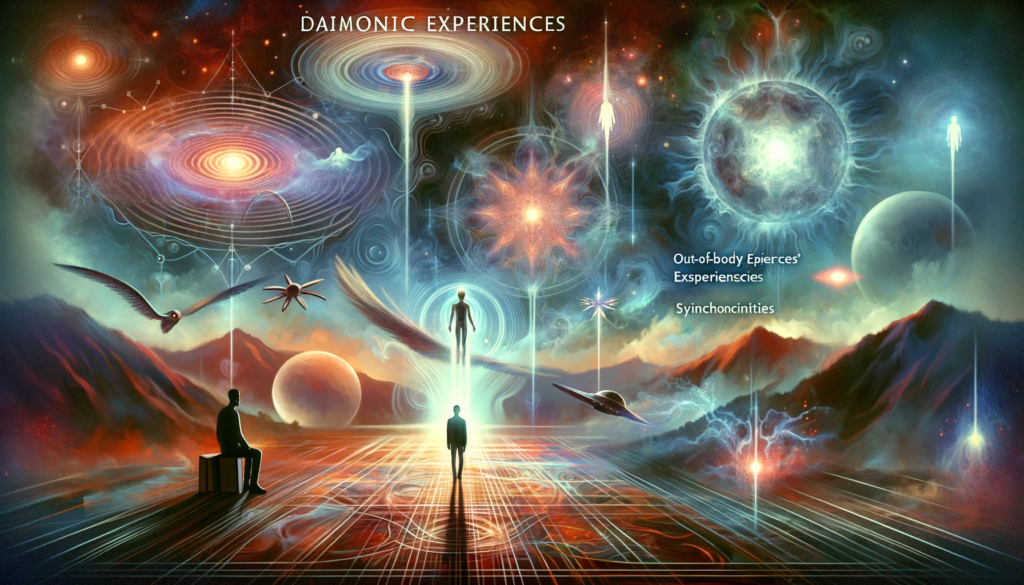Daimonic Experiences

Daimonic experiences, refer to encounters or events where the boundary between one’s inner mental or emotional state and external objective reality becomes blurred, resulting in phenomena that challenge our conventional understanding of how reality operates. The term ‘daimonic’ originates from the ancient Greek conception of a ‘daimon’ – a supernatural being or force that influences human behavior, actions, and personal destiny. The word ‘daimonic’ was notably used by Rollo May, a prominent American existential psychologist, to refer to any natural function which has the power to take over the whole person, or even the whole group of persons. These experiences have been discussed in various ways, by different cultures and across time, under names like paranormal encounters, spiritual experiences, or mystical experiences.
A daimonic experience can manifest in various forms such as synchronicities, out-of-body experiences, near-death experiences, UFO encounters, apparitions, or any event that seemingly defies our common scientific understanding of reality. These experiences are intensely personal and can have profound effects on those who have them, often leading to significant shifts in their worldview, behavior, or life direction.
In the realm of psychology, such experiences have been linked to the work of Carl Jung and his theory of the collective unconscious and synchronicity. Jung proposed that our unconscious minds are interconnected and can influence the material world in ways that can appear magical or inexplicable. This perspective proposes a more fluid understanding of reality, where the inner psychological states can somehow manifest in the external world.
Here are some specifics on this topic:
- The Stanford Encyclopedia of Philosophy references the historical understanding of daimonic beings or forces as intermediaries between the divine and the human, capable of good or evil, and linked to individual destiny.
- As reported in the British Journal of Psychology, research has indicated a strong correlation between certain personality traits, particularly those linked with creativity, and a greater likelihood of reporting paranormal or daimonic experiences.
- According to a study published in the Journal of Humanistic Psychology, people who’ve had near-death experiences often report a change in their perceptions of reality, which aligns with the premise of daimonic experiences.
Leading figures such as Rollo May and Patrick Harpur have explored these daimonic experiences in-depth. Rollo May, in his book “Love and Will”, discusses the daimonic as a primal source of energy and a force that can have both creative and destructive potential. Harpur, in his book “Daimonic Reality: A Field Guide to the Otherworld”, posits daimonic experiences as expressions of an alternative reality that operates on different principles from our everyday, consensus reality.
Daimonic experiences, while not universally accepted or fully understood within mainstream science, represent a significant aspect of human experience and have been considered seriously in various psychological and philosophical theories. Though these experiences are subjective and defy conventional empirical study, they have inspired ongoing debates and exploration about the nature of consciousness, reality, and the human experience.
One of the more complex aspects of the concept of daimonic experiences – the manifestation of physical objects or entities from these experiences. In the context of UFOs, and particularly in cases where physical evidence such as metallic spheres or crash materials are purportedly retrieved, it may be challenging to align these occurrences with the psychological or spiritual concept of daimonic reality.
That being said, if we are to apply the concept of daimonic experiences to these physical manifestations, one possible interpretation is to consider the Jungian theory of synchronicity. Synchronicity, a term coined by Carl Jung, refers to “meaningful coincidences” that have no causal relationship yet seem to be meaningfully related. In the context of daimonic experiences, these synchronicities could potentially extend to the physical world, creating manifestations that can be perceived and interacted with.
Following this line of thought, the physical evidence of UFO encounters might be seen as synchronistic manifestations of daimonic experiences, representing material symbols of a deeply personal and transformative psychological process. In this interpretation, the physical evidence doesn’t necessarily validate the objective existence of extraterrestrial entities, but rather serves as a tangible symbol of an inner psychological reality.
Rollo May, in his exploration of the daimonic, also posited that the daimonic can take over the whole person, or even a group of persons. If we apply this idea to the instances of UFO sightings or encounters, one could postulate that these shared experiences might be a manifestation of a collective daimonic phenomenon, where the boundary between the subjective and objective reality blurs not just for an individual, but for a group of people.
Furthermore, when considering the reported cases of recovered alien bodies, we can observe the similarities between these accounts and various myths, folklore, and religious narratives from various cultures throughout history. Patrick Harpur, in “Daimonic Reality”, refers to these narratives as expressions of an otherworldly reality operating on different principles from our everyday consensus reality. The alien bodies, in this perspective, might be seen as modern archetypal symbols reflecting humanity’s universal experiences and questions about life, consciousness, and the unknown.
This interpretation of daimonic experiences offers a unique perspective on the physical manifestations associated with paranormal phenomena. It proposes an alternative, psychological-spiritual lens through which to understand these enigmatic experiences. As with any interpretation of phenomena that currently elude conventional scientific explanation, it invites further exploration, discussion, and inquiry.

